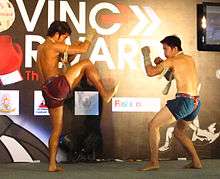Muay boran
 | |
| Also known as | Muay Thai Boran |
|---|---|
| Focus | Striking |
| Country of origin | Thailand |
| Parenthood | Indian martial arts |
| Descendant arts | Muay Thai, Tomoi |
| Olympic sport | No |
Muay boran (Thai: มวยโบราณ, rtgs: muai boran, IPA: [mūɛj bōːrāːn], lit. "ancient boxing") or originally "Toi Muay"(ต่อยมวย) is an umbrella term for the unarmed martial arts of Thailand prior to the introduction of modern equipment and rules in the 1930s.
History and folklore

In the late eighteenth century, during one of the many wars between the Kingdom of Burma and the Siamese kingdom of Ayutthaya (in modern-day *Thailand), a famed Thai boxer named Nai Khanomtom and several of his comrades were captured and held in Burma.After seven years of captivity, the Burmese king organized a festival. He wanted to see his Burmese boxers fared against the Thai boxers. Nai Khanomtom was chosen to represent the Thais against the Burmese champion. As is custom, Khanomtom opened the fight with his Wai Kru dance—this mystified the Burmese, who had never seen one before. He then brutally knocked out the Burmese champion. The Burmese thought the Wai Kru was some sort of black magic which had aided him, and the king ordered that he face more Burmese boxers. Man after man fell. The tenth Burmese boxer to face Khanomtom was a champion, but was mangled by Khanomtom's kicks and was knocked out just as the previous nine had been. After seeing this, no Burmese fighter dared step into the ring with him. The Burmese king was impressed with Nai Khanomtom, and is believed to have said, "Every part of the Siamese is blessed with venom. Even with his bare hands, he can fell nine or ten opponents. But his Lord was incompetent and lost the country to the enemy. If he had been any good, there was no way the City of Ayutthaya would ever have fallen." The Burmese king granted Nai Khanomtom his freedom along with the choice of two beautiful Burmese women or a large sum of gold (Khanomtom took the wives, saying that money was much easier to find) and his triumph is celebrated every year on March 17 in Thailand as National Muay Thai Day. However, the martial art that Khanomtom used was not called "Muay Boran." There are several old styles that were developed in various regions of Thailand that are now lumped into the term Muay Boran (literally "Ancient Boxing"), such as "Muay Chaiya," "Mae Mai Muay Thai," "Muay Lopburi," and "Muay Korat." But regardless on which regional variant it was, both have been driven to near-extinction due to the popularity of the ring sport we now know as "Muay Thai" (or, "Thai Boxing").
Muay boran was originally developed for self-defense and also taught to the Thai military for use in warfare. Matches between exponents of the art then began to be held. These soon became an integral part of Thai culture with fights being held at festivals and fighters from the different areas of Thailand testing their styles against each other. Fighters began to wrap their hands and forearms in hemp rope which not only protected their fists from injury but also made their strikes more likely to cut an opponent. Muay boran fighters were highly respected and the best were enlisted into the King's royal guard. During the 1920s-30s King Rama VII modernized the Thai martial arts competitions, introducing referees, boxing gloves, rounds and western boxing rings. Many of the traditional muay boran techniques were banned or were not practical with the addition of the new rules, and so muay boran went into decline.
See also
References
External links
| Wikimedia Commons has media related to Muay Thai Boran. |